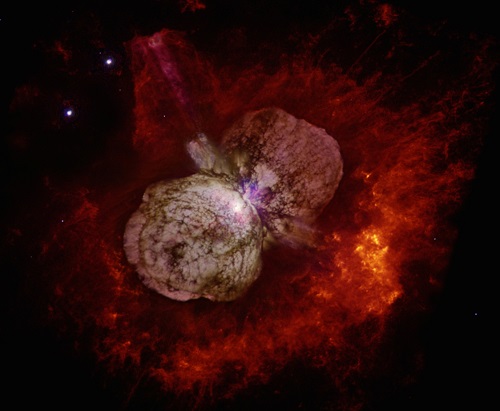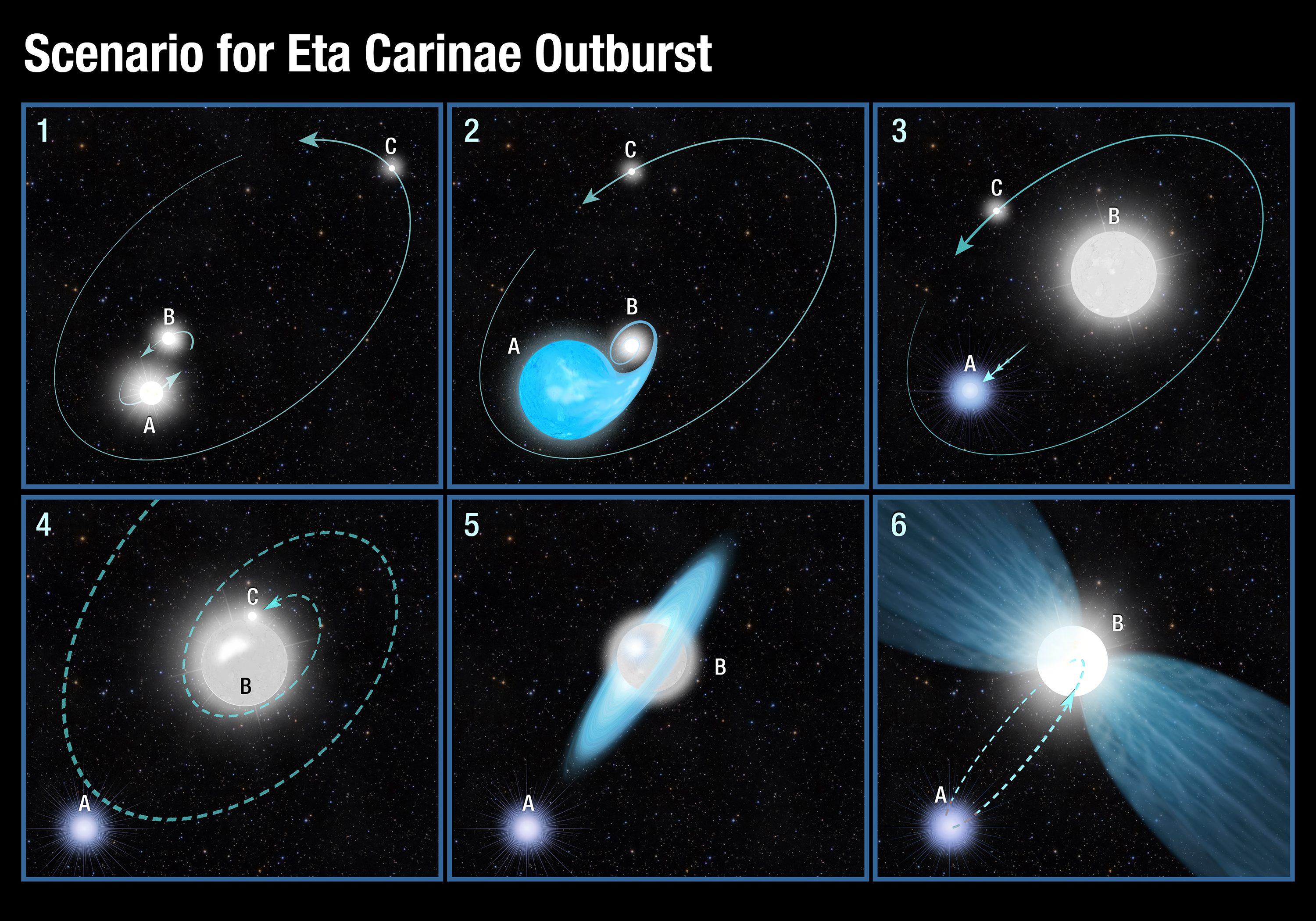170 Years Ago, a Monster Stellar Blast Hurled Gas at Record-Breaking Speed
Nearly two centuries ago, astronomers saw a mighty eruption from the massive star system Eta Carinae. Now, astronomers have measured its outburst — which sent gas flying fast enough to travel from Earth to the moon in 20 seconds.
The blast released almost as much energy as a supernova, researchers said in a statement, but it somehow left a bright star intact. And the gas sent flying is the fastest ever measured from an explosion that the star survived, according to a seven-year study of the system, which is located 7,500 light-years from Earth. The researchers detailed the new research in two papers published today (Aug. 2) in the journal Monthly Notices of the Royal Astronomical Society.
To explain the star's survival, the researchers have posited a complicated dance between three stars — two eventually merging to form the bright system seen today. [Eta Carinae: An Explosive Star System in HD Images]
The researchers measured the blast using a phenomenon called a light echo; the light from the mid-1800s eruption reflected off of dust surrounding the system, with some finally finding its way back toward Earth. Because of its more complicated journey that light is arriving after a delay, letting researchers continue to analyze the historic explosion.s
"A light echo is the next best thing to time travel," Nathan Smith, an astronomer at the University of Arizona and lead author of one paper describing the new work, said in the statement. "That's why light echoes are so beautiful. They give us a chance to unravel the mysteries of a rare stellar eruption that was witnessed 170 years ago, but using our modern telescopes and cameras.
"We can also compare that information about the event itself with the 170-year-old remnant nebula that was ejected," he added. "This was a behemoth stellar explosion from a very rare monster star, the likes of which has not happened since in our Milky Way galaxy."
This newest work came from the Gemini South telescope, the Cerro Tololo Inter-American Observatory's Blanco telescope and the Giant Magellan telescope, all in Chile.
Get the Space.com Newsletter
Breaking space news, the latest updates on rocket launches, skywatching events and more!

When Eta Carinae erupted, it was briefly the second-brightest star system in the sky at night, and it hurled about 10 times the mass of the sun's worth of material, researchers said in the statement. That glowing, two-lobed cloud of gas the system released is now known as the Homunculus Nebula. Eta Carinae is the most luminous star system in the Milky Way, consisting of two monster stars and shining 5 million times brighter than the sun (though, of course, it doesn't look that bright from Earth because it's much farther away).
And although the eruption was impressive, it's notable mostly because Eta Carinae continues to shine today, the researchers said.
"We see these really high velocities all the time in supernova explosions where the star is obliterated," Smith said. But because Eta Carinae survived, "something must have dumped a lot of energy into the star in a short amount of time."

The material is traveling up to 20 times faster than a single, massive star could likely propel it with stellar winds, the researchers said — and one explanation is that the blast was a "prolonged stellar brawl among three rowdy sibling stars," , two of which merged, according to a statement from the Space Telescope Science Institute in Maryland, which co-led the research. That interaction birthed the present-day binary system, which could have started out as a three-star system.
Someday, Eta Carinae will undergo a real supernova explosion, the researchers said in the statement — within the next half million years, but possibly even sooner. Enormous systems often show large eruptions leading up to a final supernova, the researchers said. But for now, the blast and its light echoes let researchers study a system that's very much alive.
Email Sarah Lewin at slewin@space.com or follow her @SarahExplains. Follow us @Spacedotcom, Facebook and Google+. Original article on Space.com.
Join our Space Forums to keep talking space on the latest missions, night sky and more! And if you have a news tip, correction or comment, let us know at: community@space.com.

Sarah Lewin started writing for Space.com in June of 2015 as a Staff Writer and became Associate Editor in 2019 . Her work has been featured by Scientific American, IEEE Spectrum, Quanta Magazine, Wired, The Scientist, Science Friday and WGBH's Inside NOVA. Sarah has an MA from NYU's Science, Health and Environmental Reporting Program and an AB in mathematics from Brown University. When not writing, reading or thinking about space, Sarah enjoys musical theatre and mathematical papercraft. She is currently Assistant News Editor at Scientific American. You can follow her on Twitter @SarahExplains.









